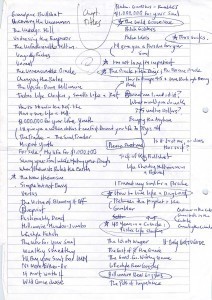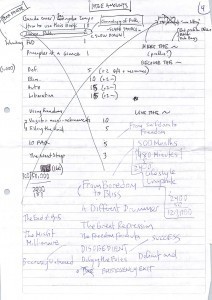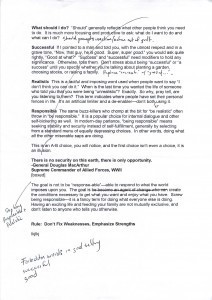Timothy Ferriss's Blog, page 124
February 23, 2011
"Good News! You Don't Die."

Courtesy of Hugh MacLeod
The following piece is an exclusive excerpt from 'Evil Plans: Having Fun on the Road to World Domination' by Hugh MacLeod. Enjoy!
Enter Hugh
People love to imagine a worst-case scenario. Especially when it comes time to quit doing what they hate and start doing what they love instead.
Cindi is a very bright young friend of mine with a great career in front of her. She's about twenty-six, and she's been working her tail off in New York in the graphic design industry since she graduated from college a few years ago.
Cindi grew up in a single-parent household, so there was never a lot of money around. That's OK; her mom was one smart, fun, tough cookie, and Cindi and her siblings always got good grades at school, so it all worked out rather well.
While she was getting her degree, Cindi had to pay her way through college. Happily she found this job (a) she really liked (b) was really good at, and (c) paid really good money: waiting tables at this fancy restaurant in Manhattan. She held down that job for years.
When I met her, Cindi was working for this small but kinda-sorta successful design agency, call it Acme Design (not its real name). It was founded by a pretty smart entrepreneur type, call him Joe Acme (not his real name, either).
When I met her, she was working all hours, doing a really good job. Busting ass, to put it plainly.
A few months ago, the phone rings. It's Cindi.
"I'm thinking of quitting Acme," she says.
"But I thought you really liked your job?"
"I did at first," she says. "But I don't think the company's growing anymore. Plus, I think Joe's gotten more interested in his new, far-too-young girlfriend than he is in growing the company. The same week he told us we weren't getting any new pay raises this year, he bought the chick a brand-new Audi coupe."
Ah.
"Besides," she continues, "I think I might want to start my own thing. I'm starting to get nibbles from potential clients wanting to work with me."
Ah!
"I just want to pick your brain," she says. "What do you think I ought to do?"
"Sounds like a good time to move on," I say.
"Yeah, but I'm kinda nervous about it."
"Sure, but that's normal. . . ."
So I gave her my two cents:
1. Her mother is very supportive of her idea to move on.
Besides, they get on very well. So she can always move back home to the suburbs if she needs to save money.
2. Acme Design is going nowhere, I can already tell. When a man starts trying to shtup his way out of a midlife crisis, you know there's trouble afoot.
3. Cindi tells me she has no worries about going back and working for the restaurant. Not only was the money insanely great and she liked her job, she only quit her job at the restaurant because Joe Acme told her to.
4. The money at Acme stinks. Pretty much everybody who works there is broke by month's end. Which makes it hard to stand up to Joe Acme when he's having a bad day or having a bad idea. She was making plenty of money and still doing her job at Acme before Joe made her quit the restaurant. And since she had to give up that job, she feels a lot more powerless than she used to—without any increase in revenue. Just the opposite, in fact.
5. Cindi doesn't mind the idea of going back to the restaurant. I tell her to do it. At the very least, she can save some money that way. A young woman with an extra ten or twenty thousand in her pocket has a lot more room to maneuver than a girl who's broke at the end of every month.
So a simple game plan emerges: She goes and gets her old restaurant job back, she moves back in with mom to save money, she quits her job at Acme, and then she works in the mornings and afternoons for her new design clients, since her restaurant shift begins at five p.m.
When she gets off work she goes straight back home—she doesn't bother with the after-hours thing with the guys and the gals at the restaurant. No late-night booze, drugs, and club sessions for this girl. No, she's on a mission. Her colleagues at the restaurant, sadly, are not. They're too busy being young, fun, and too coked-up to tie their shoelaces, let alone do something interesting in the long-term.
She's still young. A couple more years of waiting tables won't kill her—not if she's saving money and using her off-time wisely to build her design business slowly and surely. I'd bet after a year or two, a girl with that talent and drive would easily be able to leave her waitressing job and start looking after her design clients for much better money, easily. And she'd still be well under thirty. What's the worst that can happen?
Some of Cindi's twentysomething peers raised their eyebrows a little bit, though. "Going back to waitressing? Isn't that a backwards career move?" they said.
No, it isn't, actually. She's still young and what she's doing is consistent with what she wants to do long-term. There's no disgrace in waiting tables if it's part of a long-term strategy. If she were just doing it because she had no earthly clue what else to do with her life, that would be different. But she's not.
"The good news is," I say to her, when she was just beginning to hatch this Evil Plan of hers, "you won't die."
So she went through with her Evil Plan. I was so proud. And the really good news is, she didn't have to waitress or live with her mom for very long. Three months and she was gone. Three months and she managed to bag half a dozen high-paying clients for her business. Last time I saw her, she was wearing very expensive shoes and had moved into this very hip apartment in Brooklyn. Like I said, I was so proud.
And her colleagues back at the restaurant? They're still there. Choices were made.
# # #
Hugh's latest book, Evil Plans: Having Fun on the Road to World Domination, is available through all major book sellers. You can find more of his writing and artwork at his popular blog, Gaping Void.







February 22, 2011
Muse Case Study: Guerrilla Drum-Making
Here are some links to the site:
http://guerrilladrummaking.com
http://guerrilladrummaking.com/blog
And, here are the answers to the most challenging and easiest parts of making and launching the DVD.
Bolded parts are the main answers.
Easiest things:
Since I already had the product idea and a ton of drum building experience, brainstorming the DVD was pretty effortless. But, surprisingly, what was even easier was market selection research, micro testing and analyzing; all things that I had ZERO experience with that can either make or break your business (online or offline). And I'm not exaggerating when I say this was the easiest stuff to do… I honestly had a harder time finding out the best shipping method for my product.
And for how easy the micro testing procedure is (I literally followed the "Testing The Muse" chapter like it was going out of style), there's no reason why people shouldn't pursue even the smallest idea to test the demand of it. You'll know instantly whether you need to rethink your strategy, invest, or bale. My entire micro testing cost me $330 which included buying domain names, outsourcing web work, outsourcing graphic design, web hosting services and google adwords. Market and competition research, web copy and clever adwords headlines took me about two weeks and I alloted one week for testing the demand of the product with adwords advertising. After tallying up the stats and analyzing the data, it took about 2 seconds for me to pull the trigger and get the ball rolling on this DVD.
Hardest things:
Of the entire process from product creation to the launch of DVD, the biggest obstacle that I had to overcome was realizing that I had to thoroughly break all the "internet marketing" rules; they just didn't fit my personality or the brand of Guerrilla Drum Making. The DVD is edgy, groundbreaking (it's the first drum making dvd ever), it's fast paced and it's a very creative DVD for a "how-to" product. I just couldn't settle on some cheesy ass web site, an overly persuasive and pushy e-mail marketing campaign, etc.
I interviewed copy writers, internet marketing gurus, adwords experts… one after another, and they all had the same opinion. They were all bound by the same rules. These guys wanted my site to look like I was selling the SHAMWOW or something. I literally had to write in my elance job postings for copywriting, "If you are going to suggest highlighting my most important headlines in yellow block-out, don't even think about bidding on this job." I talked to one "marketing guru" that said on the phone, "Listen… the secret to internet marketing success is to sell, sell sell. Your not going to have ANY sales without salesy copy, a killer one-of-a kind deal on your product, and a fantastic opt in for your future clients." I told that guy to go to hell… I'm not a car salesman. I'm a musician and I like cool things. I'm my first customer and my biggest critic and I have never, and will never buy anything from a website that looks like that. NEVER. Those products always suck.
So that was very hard for me. It took almost a whole year to realize that what everyone on earth was suggesting was NOT right for my product. The internal debates; "Do I just go with what these experts are saying, or should I do what I think is right?" That kind of stuff keeps you up at night.
>>>(((Tim, by the way, check out "JOJO MAYER and NERVE" on itunes. Unreal drumming and musicianship, made to simulate drum and bass culture (theres only three guys in the band. Thanks again and let me know about this or wahtever else you may need.))))))<<<







February 16, 2011
How to Master the Art of Seasoning: 5 Tips for Reinventing the Slow-Carb Diet

The Slow-Carb Diet need not be boring.
Moreover, it doesn't take much to jump from repetitive to inventive. In my case, even as a grass-fed beef aficionado, I grew weary of flank with nothing more than salt and pepper. Game meats made things more interesting, but the real gold was struck when I began experimenting with Montreal steak rub and, separately, a mixture I remembered as "CPR": cumin, paprika, and rosemary.
Delicious, not to mention biochemically kick-ass for your heart and anti-inflammation.
The point being: for many people (in particular, cooking-inept bachelors like myself), Slow-Carb meals sometimes become an exercise in culinary deja va. This is often paired with common beginner frustrations:
- How do I drink coffee without milk?!? (Answer: cinnamon and/or vanilla extract)
- What can I put on my eggs? (Answer: read this post)
The solutions need not be complicated. In this post, Jules Clancy will focus on primarily spices and include: beginner tips, a starter recipe experiment, and a shopping list for the fundamentals.
Jules is a qualified food scientist who was introduced to me by the minimalist maestro himself, Leo Babauta…
Enter Jules
As you'd expect from someone who blogs about food for a living, I dove straight into the Slow-Carb Diet chapter after picking up my copy of The 4-Hour Body. (Actually, it was right after checking out the chapter on 15-minute female orgasms. What's a girl to do?)
The one thing that bothered me about the Slow-Carb Diet, though, was the assumption that it would be boring for most people. Simplicity does not have to equal boredom. The Slow-Carb Diet can, and should, be both fun and delicious.
If you are willing to learn the basics of seasoning, a world of variety and amazing food can be yours with minimal effort.
5 Tips for Overcoming Boredom on the Slow-Carb Diet
1. Lay the foundation with salt & pepper
One of the oldest but best tricks in the book. I can't stress enough how important it is to get your basic seasoning right to maximize flavor. Forget what you've been told about the perils of a high sodium diet; the amount you'll be adding will be minuscule compared to what's put in by food manufacturers. For slow-cooked dishes, it's a good idea to add some salt in early so it can spread through the whole dish over time. For other dishes, seasoning at the end is the best way to go.
2. Harness the power of acid
While the warm and wonderful Thai people mastered the balance between sweet, sour, salty, and heat ages ago, it's actually something I learned to appreciate during my wayward years as a winemaker.
At winemaking school, we did many experiments where we would 'doctor' a wine with different types and amounts of acid. We'd then taste the different samples to see which ones were best. It was incredibly enlightening to see the difference that sourness played in the wine. At the optimal acid level, the wine would be more bright and alive on the taste buds. It would sing.
I've since learned to apply this to my cooking. When something doesn't taste as fresh as I'd like and I've already given it a bit of salt, my next step is to add a little vinegar or a squeeze of lemon. Test this on some steamed veg or wilted spinach, and you'll see how dramatic the difference can be.
3. Unleash umami (a flavor explosion) with humble soy sauce
The Japanese were the first to recognize the fifth taste, umami (also called "savoriness"). Foods that are high in umami components are delicious tasting things like beef, tomatoes, mushrooms, and Parmesan cheese.
It is said that soy sauce was invented by Buddhist monks to make vegetarian food taste more like meat. Soy is all about the umami, and a little bit can turn almost any food (not just Asian dishes) into a flavor explosion.
4. Add depth with chili
It's hard to beat the wonderful warming feeling you get from a bit of chili. While I like it hot, it's more about feeling the warmth and still being able to taste what you're eating, rather than having your mouth burst into flame. For one suggested brand, check out Dave's 6-chili pepper flakes shaker for a variety of heat levels.
5. Spice & herbs – the accessories of the kitchen
Using herbs and spices is where you can really start to have fun breathing variety into an old faithful dish. A little curry powder can have your taste buds on a passage to India, whereas the same dish treated to some chili, lime, and fresh cilantro will transport you to Acapulco. See the suggested variations on the recipe below for more ideas on how herbs and spices can work for you.
Suggested Starter Experiments to Try
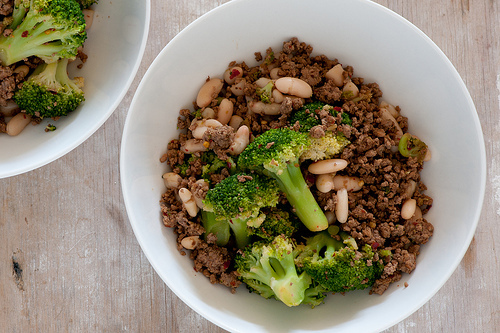
Beef & broccoli stir-fry with beans
Serves 1-2
[5 ingredients | 10 minutes]
Feel free to play around with the seasoning on this one. I like to use dried chili flakes because they look nice, but by all means use whole dried chilies or chili powder.
If you'd prefer to use fresh broccoli, substitute in 1 or 2 heads chopped into florettes. I used white cannellini beans but black beans, pinto, etc. are all equally delicious.
1lb (450g) ground beef, preferably grass-fed
1lb (450g) bag frozen broccoli
1-2 teaspoons dried chili flakes
4 tablespoons soy sauce
1 can beans (14oz / 400g), well drained
Preheat a large frying pan or wok over high heat. Add a few tablespoons of macadamia or peanut oil, then add the beef.
Fry the beef for a few minutes, stirring constantly to break up the chunks and to get the beef browned evenly all over.
When the beef is no longer pink, add in the broccoli. Cover with a lid, baking sheet, or foil, and cook for 2 – 3 minutes, still on high heat.
Stir and test broccoli. It should be bright green and no longer frozen in the middle. If it's still cold, continue cooking with the lid on for another minute or so.
Add chili and soy sauce. Stir and taste. If you think it needs a flavor boost, add more soy or some salt. Likewise with the heat level and the chili.
Add drained beans. Stir until beans are warm.
Here is a video version of the above recipe to guide you through the steps:
Alternate Serving Suggestions:
Once you've mastered the basic version above, you can really mix things up by modifying the way you prepare the meal. It's amazing how different this dish can taste with a few simple tweaks.
Option #1: Beef & broccoli on a bed of mashed beans
Instead of adding the beans at step 6, crush the drained beans with a fork and stir in a little olive oil. Serve beef and broccoli on top of the mash. The heat from the stir-fry will warm up the beans.
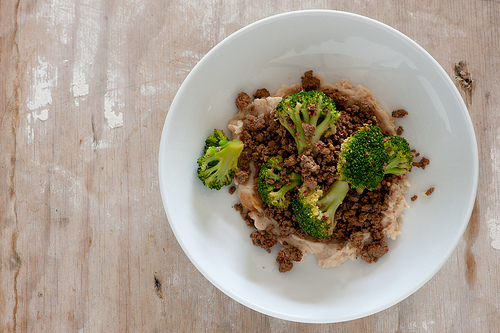
Option #2: Beef & beans with steamed broccoli on the side
This is a good option for people who are a bit shy when it comes to eating greens. Just nuke the broccoli for 4-5 minutes on high, or boil for 3 minutes and drain. Cook the beef and beans as per the recipe above, skipping steps 4 and 5.

Option #3: Beef on a bed of mashed beans with steamed broccoli on the side
Crush the drained beans with a fork and stir in a little olive oil. Microwave the broccoli separately for 4-5 minutes on high or boil for 3 minutes. Cook beef as directions state above, skipping steps 4 & 5. Serve beef on a bed of mash with broccoli on the side.
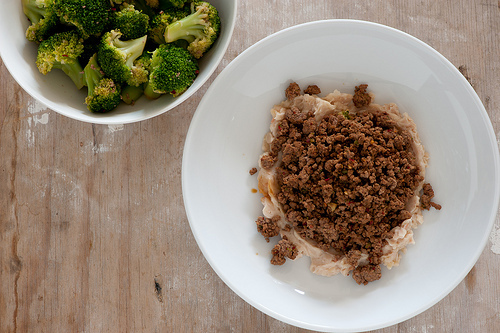
Bonus: Essentials for the Perfect Pantry
If you're just getting started with building out your pantry, the below list will give you a solid foundation of seasonings you can use for any occasion.
Salt. I prefer salt flakes (such as Maldon) that have a nice large flake structure, making them perfect for crushing over meals at the last minute. Iodized salt is great for people who don't get any seafood in their diet and can help combat hypothyroidism. Plain kosher salt is also an excellent, tasty option.
Pepper. If you don't own a pepper grinder, a disposable bottle of peppercorns from the supermarket will suffice. However, there truly is no substitute for the fragrance of freshly ground pepper. I prefer black peppercorns because I find that white pepper has a nasty odor.
Sauces. I highly recommend starting out with a bottle of soy sauce. Don't only have it with Asian-inspired dishes; use it instead of salt whenever you crave a more intense, savory flavor. If you like spicy foods, a bottle of Cholula or Sriracha will be indispensable. Oyster sauce is great for lovers of Thai food.
Spices. Take it slow. Start with dried chili flakes, chili powder, or whole chilies, then add 1-2 of the following to your pantry at a time:
– Ground cumin. Combine a tablespoon of this with an equal amount of olive oil, then use it to marinate your steak before cooking. A pinch of cumin will also add a new dimension of flavor to a tub of hummus.
– Ground coriander. Sprinkle some over cooked fish or pork. It's also brilliant when added to your spinach before microwaving.
– Curry powder. Add a few teaspoons to your lentils before heating them for lunch. I love to add a little to my scrambled eggs.
– Smoked paprika. Use as a dry rub on chicken before grilling. It's also wonderful with tomato-based dishes.
Acids. Vinegar is easiest because it lasts for ages. Go for either balsamic, red wine, or sherry vinegar. Try combining 1 part vinegar with 2 parts olive oil for an instant sugar-free salad dressing. Also, a tablespoon of vinegar stirred through warm canned lentils really brings them to life.
It's hard to beat the freshening flavor properties of citrus juice and, as Tim's experiments showed, lemon juice helps to lower glycemic response. I always keep a few lemons in the fridge for drizzling over cooked spinach. Limes can be lovely as well for creating a more Mexican feel.
Herbs. Dried herbs tend to just make everything taste like stale weed. Stay away from herbs until you're ready to either handle them fresh or start growing your own in a window box. When you are ready to give them a shot, start with basil (great with anything tomato-based) or cilantro (coriander) for its wonderful freshness.
Anything else? I always have some canned tomatoes or tomato paste in my pantry, along with a jar of roasted red peppers. While not strictly seasonings, they are great for adding variety and a bit of instant veg. A jar of pesto can be a great flavor hit, as well.
###
Jules Clancy is a qualified food scientist. She blogs about her commitment to cooking recipes with only five ingredients at Stonesoup.com. She also runs an online cooking class, Reclaim Your Waistline, featuring recipes that take 10 minutes or less to cook.
Question of the Day (QOD): Do you have an awesome, non-boring Slow-Carb recipe you want others to try? Submit it here to potentially have it featured in the next version of the Slow-Carb Diet Cookbook!







January 31, 2011
Feeling Stuck? Read This…

Parc del Laberint d'Horta, Barcelona (Photo: Marcel Germain)
Big successes often seem like foregone conclusions.
In reality, most entrepreneurs (read: creators) who appear to have unique genius suffer through the same frustration as the masses of unknowns. They simply test and persist a few steps further.
Richard Branson will tell you this of his Virgin empire.
Tony Hsieh of Zappo's shares similar stories.
Steve Martin can prove that it applies to anything creative, not just business.
Below is a piece of paper from 2005 I recently unearthed while purging books and folders from my house.
It reflects a complete failure–protracted over weeks–to find a good title for what later became The 4-Hour Workweek (4HWW). Most of the ideas are horrible beyond belief, and it wasn't until I tested a few variations using Google AdWords that we decided on "The 4-Hour Workweek," which I still disliked on multiple levels.
Here are two pages of frustrated attempts, two pages of dozens (click to enlarge, then click again)…
Let me know which title is your favorite ridiculous option. "This Sucks," perhaps?
But, moving on, what of 4HWW writing itself?
I'm pleased to report that the writing flowed like a crystal clear stream. Perhaps a torrent of genius. Sometimes–how should I put this–I amazed even myself.
Oh, wait a second, I lapsed into fiction. Back to reality: the writing, for the most part, made me want to Hemingway myself. On good days, I'd settle for the impulse to slam my own head in a car door.
I tossed the first four chapters I wrote and almost gave up on multiple occasions. Futility was the brain soup du jour. Draft, doubt self, panic, hate self, throw out draft–rinse and repeat.
To give you an idea of how many rewrites it took to get right, here are two early draft pages of a sample chapter. Far from the worst I produced, but still far from polished (click to enlarge, then click again):
It changed only when I started viewing each chapter as a magazine article: strong enough to be a stand-alone piece, including a clear opening or "lede", a clear middle with case studies, and a punctuated end with lessons learned.
From that mindset, a few trial runs, I developed a chapter template that involved starting with a dialogue or anecdote (even if it was scrapped later) and moving through the above steps to a resource-rich "Tools and Tricks." I needed a repeatable process. To sit down to "write a book" was just too overwhelming, even with a table of contents as a blueprint.
If you plan on any creative undertaking, whether business, writing, or art, I strongly recommend the book Bird by Bird: Some Instructions on Writing and Life by Anne Lamott. If you spend a lot of time working alone and get trapped in your head, it's required reading.
It saved my sanity and has done the same for several friends who've gone from "I want to quit" to New York Times bestsellers.
In Conclusion
Most miraculous successes are nothing of the sort.
Those on front lines, the people who seem to jump into the limelight from nowhere, experience the same plodding frustration and trial-and-error as the rest of the world.
They differ in that they don't expect luck to help them, nor good fortune to save them. As James Cameron would say: "Luck is not a factor. Hope is not a strategy. Fear is not an option."
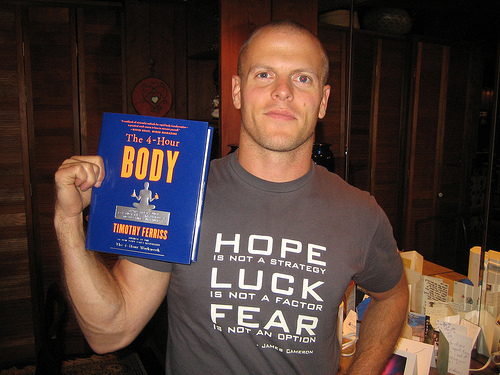
Sporting my game shirt a few weeks before the launch of The 4-Hour Body. The book itself is a "looks like" mock-up with blank pages.
James might also tell you that the best creators are like ducks. They appear to glide along serenely on the surface. Beneath the surface, however, they're kicking like a motherf*cker.
Keep calm and carry on.
###
Odds and Ends: NYC Launch Party Highlights!
The following video was shot and edited by the incredibly talented Michael Gebbs.
The NYC launch event was an all-around huge success. Sadly, NYC weather decided to serve the coldest day of the entire season, and an unexpected mandatory coat check (due to fire hazard potential) backed up the line and left more than a few people freezing for far too long. This led some people to abandon ship, including many of my closest friends and family. I did my best to take notes, learn from it, and make amends.
For positives, the event helped raise almost $10,000 for DonorsChoose.org, it was a total blast, and I'm planning a summer party in NYC with a slightly smaller crowd.
I hope you enjoy the video:
Tim Ferriss 4-Hour Body Launch Par-tay New York City! from GEBBS on Vimeo.







January 28, 2011
Random Episode 87 (or not): Kevin Rose and Tim Ferriss talk knives, iPhone apps, flutes, and dog handling
After a long hiatus, here is a new episode of The Random Show! It's not episode 87, but we couldn't remember the number. Click here for all of our magical past episodes.
In this hang-out discussion, we enjoy a frolicking romp (c'mon, not that kind) through:
- Booking media and how-to tips
- How to build iPhone apps, how Kevin's doing it, how to assemble (and pay) a team, and DIY tips
- How Kevin's puppy effectively bites through mic cables
- Knives for military or survival use — Tim's newest and perhaps oldest obsession
- 2010′s resolutions and 2011 New Year's Resolutions…
A few URLs mentioned are:
foodzie.com/subscription
curetogether.com/
patientslikeme.com/?
spectracell.com/
michaelpollan.com – The Omnivore's Dilemma
foodincmovie.com
fourhourbody.com/
Knives:
Kershaw Leek knife (what I had on my belt)
The Grayman Warrior
Boeker fixed blade (suggested by Yvon Chouinard)
ESEE-5 Randall
Evasive driving and Special Ops training:
http://www.safehouse.com/

January 25, 2011
From First TV to Dr. Oz – How to Get Local Media…Then National Media
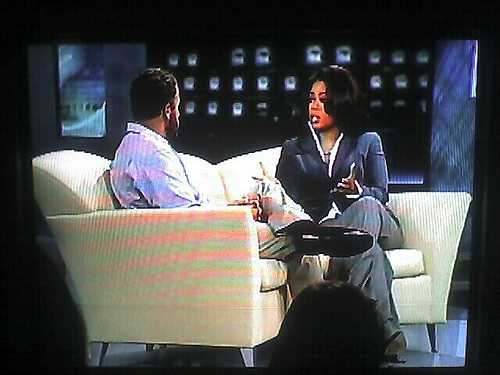
(Photo: Dyobmit)
Let's start with what you think you want.
"I want to get on Oprah eventually, and we've been pitching The New York Times, who's interested."
Good news or game over?
I hear some version of this on a weekly basis from start-up founders. Sadly, most of them aren't prepared for national media and do more harm than good with a premature (and non-strategic) jump into the spotlight. The New York Times doesn't often do two major stories on a single company, so that first — and possibly only — appearance is what counts.
But what of lack of media attention? Indeed. There are two main media challenges:
How do you get media interest? Big media interest?
How do you ensure you're prepared when a big opportunity presents itself?
In both cases, you chart a course and execute. In this post, I'll show how I went from my first real TV exposure to appearing repeatedly as a guest on national TV shows. I'll also share the exact e-mail pitch that led to a Wired feature, as well as recorded radio interviews.
Media coverage isn't magic, and it need not depend on luck. It can be a step-by-step process…
Step 1 – Create a Reel
The time was mid-February, 2007. The 4-Hour Workweek was slated to publish on April 27th, and I had a problem: no one in television knew who I was, and I wanted to be on national TV for the launch.
The chicken-or-the-egg problem was simple: big TV doesn't want you on until you've proven yourself on big TV. What to do?
My answer was: look for a local affiliate of big networks like ABC, CBS, or NBC, and find something controversial and timely to discuss. I began to read the news (a rare event) and realized that a soon-to-be-published book was making waves — Game of Shadows: Barry Bonds, BALCO, and the Steroids Scandal that Rocked Professional Sports.
I knew a few people directly involved with BALCO, and — as a sports nutrition company CEO at the time — I was in a qualified position to talk about drugs in sports. Digging into advanced excerpts of Game of Shadows (GOS), which was billed as a "drug-by-drug account" of high-level athletics, I formulated a simple and valid position: far from decreasing drug use, the book would end up serving as a how-to guide.
GOS was going to be published on March 1, 2007. The week before publication, I reached out to all local San Jose or bay area-based big networks. I called the switchboard or main number, requested "the newsroom," and started the pitch, which was written out on paper in front of me and never lasted more than 20 seconds:
"My name is Tim Ferriss and I have a timely pitch for you. I work with professional athletes and… [establish credibility as CEO and someone with experience in drugs in sports]"
"Game of Shadows, about Barry Bonds and BALCO, comes out next week and it's getting a lot of attention. Most of the world is viewing it as an exposé that will decrease drug use. They're wrong. I can discuss why it will actually increase steroid and drug use."
Most calls went to voicemail, a few people said they'd get back to me, and only one did: NBC 11 in San Jose.
But one is all it takes. The short NBC clip ended up being the social proof later needed to get me on The Today Show and others for The 4-Hour Workweek.
Remember: make it timely and controversial. "Controversial" doesn't necessarily mean scandalous; it means a position that runs counter to the mainstream or expectations.
But does the "reel" only apply to TV?
Not at all. The same can be done for radio, which is a far easier sandbox to play in, as there are more players. I started with Lamont and Tonelli on KSJO 92.3 and a stunt for Fairtex kickboxing. I invited the hosts to a demo and encouraged their sidekick, Sully, to get in the ring and do some light sparring.
It was fun and had absolutely nothing to do with anything I'd do in media later. It didn't matter. The producers of radio — just as in TV — simply want to know you'll speak clearly, be entertaining, and not embarrass them. The subject matter doesn't matter. On a higher level, they want to know: can you help design a fun segment?
I later parlayed this early radio, along with other random samples, into booking "radio satellite tours" with the help of Peter Marchese. "Radio satellite tours" entail sitting in a room with obscene quantities of coffee and doing back-to-back 10-30-minute radio interviews from 7am to 5pm with almost no space for even bathroom breaks. It's batching at its efficient best… and punishing worst.
Here are four of my 20+ interviews, here listed in order from December 16, 2009. You'll note that I launched the revised edition of The 4-Hour Workweek in the same week as I later launched The 4-Hour Body. It was a dress rehearsal for the big game, a dry run for understanding the dynamics and competition of the X-mas season.
Note the talking points (we'll return to this) and examples, which I repeat ad nauseam with slightly different segues:
0920-0930 – Reg IA-Nebraska
1105-1115 – Albuquerque-SantaFe
1145-1155 – Denver
1410-1420 – National
But what of these talking points?
Step 2 – Know Your Subject: In Depth vs. Talking Points
To prepare for the NBC TV interview, I had to:
- First, visit a Borders and literally get on bended knee to beg for a copy of Game of Shadows the afternoon before release. The simple begging didn't work. Several book chains had been shipped Harry Potter late as punishment for releasing a prior Potter before the mandated midnight release time. I finally offered, "What if I do headspins for you? I'm totally serious. Puleeeeease?" after which, I jumped into a breakdancing freeze on the floor. I'm not kidding. Pretty pathetic, but they laughed, relented, and went to the back storage room to get the book.
- Second, digest a 368-page book in one evening, which I did over espresso (limit: two singles per hour) and wine (limit one glass pinot noir per hour) at Santana Row in San Jose. Here is a one-page index from that session:

- Third, prepare main talking points and sound bites. This involved taking the above notes and observations (I had several other pages) and whittling them down to 3-6 major points I could convey in a total of 120 seconds, 20 seconds or so per point.
Here are the talking points I used for a recent Newsweek interview on The 4-Hour Body, which became a feature piece called "The World's Best Guinea Pig":

(Click here for larger version)
I answer a few things on this small sheet:
"Why is what I'm doing different or controversial?" (Answer: using new tools to scientifically test all of the myths and old wives' tales on myself and others)
"Why is this timely and important?" (Answer: I'm part of a much larger trend; cite books and growth of Quantified Self, etc.)
"What are some actionable examples of counter-intuitive findings?" (Answers: 30g within 30 min of waking, replacing milk in coffee with cinnamon, etc.)
For the last group of actionable takeaways, I list them first, then number them in descending order of priority for inclusion. If these sound familiar, you're right. They're the same talking points I used in the above radio satellite clips.
NEVER assume you'll get to cover everything you hope or rehearse. Media is unpredictable. I had to account for this in my recent appearance on The View, as just one example (notice we skipped over half of an entire table, as questions from Barbara required it). I didn't get frazzled, as I had planned for this and prioritized my points, both mentally and logistically — the latter by ordering props on the tables.
Step 3 – Pitch Properly
Why is pitching step 3 instead of step 1?
Because it makes no sense to pitch until you have your prep (reel or sample clips) and basic positioning (timely and controversial angle with examples) in place.
Then, before you start spamming people with template emails, keep in mind: Thou shalt know thy media outlets. Don't pitch the same thing — or something general — to niche outlets. It's a waste of their time and yours. Know the magazine or program and customize.
Here is the actual pitch I used for Wired Magazine that ultimately led to the 4+-page feature entitled "Tim Ferriss Wants to Hack Your Body." It lacks a self-intro, as I'd met this editor in person, an approach I always encourage, as e-mail is the most crowded channel.
Notice that I provide different options/ideas for different lengths:
Hi [Name],
OK, here are a few ideas. They're in three categories:
1) Feature
2) Shorter 1-2 page piece
3) Book mention in Playlist
My preference if possible, no big surprise, would be 1, 2, and then 3. Here are the toplines:
1) Feature:
For Wired readers, being one myself and having been in the mag before, I think one of my chapters as an exclusive excerpt would be the least work for Wired and the best fit. It's ready to go and would just need to be tightened for space. I've attached the latest version (sorry for the hand edits). Here are some headlines and toplines:
BLOOD HACKING: Creating the Perfect Fat-Loss Protoplasm
I implanted a medical device in my side that sampled interstitial glucose levels every 5 seconds. It's used by cutting-edge Type 1 diabetics, but I used it to figure out which foods and meals would make me fat. I wore it 24/7 for weeks, including a trip through customs to Nicaragua. There some sweet graphics and nice how-to takeaways I can provide.
Other potential headlines:
Tracking Blood to Lose Bodyfat
BLOOD: Self-Experimentation for Losing Bodyfat (could appear on the cover like this: http://www.flickr.com/photos/timferriss/5388565667/ [NOTE: In the actual e-mail I used a private Skitch link]
Diary of a Blood Tracker
2) Shorter 1-2 page piece
This would detail 5 or so of the coolest and craziest drugs and tools I used in my experiments over the last 3 years, ranging from the above medical device to stem cell growth factors, anabolic steroids, IGF-1, and more. I could write it or it could be a Q&A with me. Potential headlines/titles:
BECOMING SUPERHUMAN: Drugs and Gadgets to Make You a Mutant
Gadgets and Tools for Becoming Superhuman [this one would omit drugs]
BECOMING SUPERHUMAN: An Interview with Human Guinea Pig Tim Ferriss
3) Mention in Playlist — Pretty straightforward here. Just a book mention and little blurb.
Look forward to your thoughts, [name]. Wired is a great place to break this one.
Cheers,
Tim
###
Afterword: Is this type of media how-to of interest? If so, I'll do a "Part 2″ continuation of this post and talk about media training and other little-known aspects of the game. In the meantime, please find my most recent Dr. Oz clips below.
Also, if you've read The 4-Hour Body and haven't yet left an Amazon review, please take 30 seconds to do so here — I'm need a few more to pass 1,000 reviews (currently 965)! Thanks for your feedback, all. It's what keeps me going.
[image error]
[image error]
[image error]
[image error]
[image error]
[image error]
Elsewhere on the web:
Financial Times – The Last Word: Lessons in Online Marketing
AskMen – Long Q&A, including questions on anabolics and other performance-enhancing drugs







January 21, 2011
Housecleaning and Clarifications: Blog Content, 4HB Corrections, Competition Winners, Slow-Carb Mistakes, and More

(Photo: Felipe Morin)
Holy crap. The 4-Hour Body (4HB) has ended up producing an avalanche of questions.
There are definitely a few gems hidden amongst the rubble, and more than a few typos were unearthed in the process.
This post — mostly how-to with a few bits of entertainment — is purely for tying up loose ends. I hope it helps.
Covered in this post:
The blog moving forward: 4HB content vs. 4HWW content vs. random topics
4HB Bonus Materials – If You Missed It
4HB Tools and Tricks – All Online!
Contest winners
Slow-carb clarifications
4-Hour Body – common questions and Q&As
Audiobook PDF downloads
4HB reader-generated goodies: desktop wallpaper, etc.
Media samples
4HB corrections and typos…
###
The blog moving forward: 4HB content vs. 4HWW content vs. random topics
Some readers have expressed interest in more business-related posts, instead of physical-focused posts. Not to worry — there will continue to be both on this blog. In simplest terms, I write about what I'm most interested in (or passionate about) at the time. If you don't find a post interesting, skip out for a bit and then check back in. I don't expect anyone to read all of my posts.
4HB Bonus Materials – If You Missed It
The 4-Hour Body bonus materials have been up for a while now. If you missed them, all can be found here. Enjoy!
There are a number of forums and message boards for 4HB, including this blog and the reader-generated 4HBTalk.
For those interested, I'll be experimenting with a private, paid forum (probably $9.95/month to start, but not sure) for 4HB. I'm going to test it with 100 people first. If you have any interest in being one of the 100 for $9.95/month, please fill out this form. My hope is that this forum can be a central troll-free and spam-free gathering point for people who are willing to test, gather data, and contribute to each other. I don't want participants who ask others to Google simple questions for them. The price is a simple mechanism to separate out those who are most serious.
Regardless, information wants to be free. There are a ton of free resources and communities online, not to mention a 600-page book, that should be enough for anyone to make exceptional progress.
4HB Tools and Tricks — all online!
Ever wished all of links in the 4-Hour Body "Tools and Tricks" were online? You asked and I heard you — all of the resources links are now online here. Enjoy!
Contest winners!
CONTEST #1
Blog post: Have a Good Eye for Ads? Try the (Lucrative) 4-Hour Body Experiment…
Date: October 13
Winner: Salman Sajid (Congratulations!)
Prize(s): North Face Prophet 65 Trekking Pack (Retail: $319), A round-trip anywhere in the world Star Alliance airlines fly (or $1,000 cash), All 4-Hour Body revenue via ads on my site for two weeks (potentially every post ever written), using your Amazon affiliate code.
Notes: Here is Salman's winning ad (he also won the smaller banner), based on click-through rate. I'll be doing a longer analysis in a future blog post. The genius "Eat Like Santa, Look Like Jesus" ads, which I also used to great effect, was designed (visual and copy) by Conway Anderson. Amusingly, he and I randomly met on the Embarcadero sidewalk on the SF waterfront. He gave me his card "just in case" and here we are.
CONTEST #2
Blog post: "The Land Rush: 48 Hours to Claim $4,000,000 in Prizes" "The 4-Hour Body is NOW OUT – Live Q&A Today, New Trailer, Free Books, and Much More"
Date: December 2010 (sadly, there were some great submissions who posted too late, like David Batchelor)
Winner: Camille. Runner-up:Roger P.
Prize(s): Free trip to the person who promotes The 4-Hour Body best this week. If you are the best promoter, judged by me and a panel of friends, you get to pick one trip of a lifetime… for free. I will almost definitely be in attendance: 8-Day Argentina Snow Adventure in Patagonia, or 10-Day Private Tour of India, including Miss India. Includes roundtrip economy airfare from and back to the U.S. Addendum: I'll give the runner-up a round-trip anywhere in the world that Continental flies (or StarAlliance). Camille, you can also take this, if you prefer. No expiration date.
Slow-Carb Clarifications
I'm currently getting at least 500-1,000 questions a day via the blog, Twitter, Facebook, etc. about the slow-carb diet. Let me clarify a few things:
Do not eat the following, except for cheat days:
Yams
Sweet potatoes
Quinoa
Dairy (this includes cheese and yogurt of all kinds)
I mention cottage cheese at one point as a last resort. It is low in lactose, which is what you need to avoid. Ghee and cream (for coffee) should not contain any lactose, hence you can use them. The same goes for effectively lactose-free, unflavored whey protein, etc..
SUPPLEMENTS: There is NO need for supplements on the slow-carb diet, besides magnesium, potassium, etc. in "Slow-Carb II." PAGG is NOT necessary, so if you find it confusing, just omit it.
Post-workout carbs – If your goal is fat loss, and assuming you are not training for endurance competition:
- If you male and not 12% bodyfat or less, no post-workout carbs.
- If you are females and not 20% bodyfat or less, no post-workout carbs.
In the end, the point of 4HB is intelligent and responsible SELF-EXPERIMENTATION. I will not answer all of your questions, precisely because I want you to think for yourselves and figure it out. Hundreds of you have already done. It's not that hard.
The following will address 99% of those who are confused:
- If you have to ask, don't eat it.
- If you haven't had blood tests done, I don't want to hear that the diet doesn't work.
- If you aren't measuring inches or haven't measured bodyfat % with an accurate tool (BodPod, etc. and NOT bodyfat scales), I don't want to hear that the diet doesn't work.
- If you're a woman and taking measurements within 10 days prior to menstruation (which I advise against in the book), I don't want to hear about the lack of progress.
- On the critical 4-6 week window:
For people over 40 and women (especially after two kids), it's quite common that the most dramatic fat-loss and weight change comes after 4-6 weeks on the diet. I have explanation for this. Needless to say, if you haven't done the diet for AT LEAST four weeks, please don't post a comment about plateauing and panicking. I can't give you meaningful advice without a ton of other supporting data (blood tests, etc.), and it's physically impossible for me to respond to each person.
To reiterate: The entire goal of 4HB is to make you a self-sufficient self-experimenter within safe boundaries. Track yourself, follow the rules, and track the changes if you break or bend the rules. Simple as that. That's what I did to arrive at my conclusions, and that's what you will do — with a huge head start with the 4HB — to arrive at yours.
Do it for 4 weeks and then troubleshoot if you're plateauing.
If you post a plea for help anywhere, include at least two FULL days of your meals and snacks so people can actually help you.
Most of those saying they're "following the diet to the letter" are doing nothing of the sort. Reread "Slow-Carb II" in 4HB.
Last, I'll repeat the basic approach to the unknown: If you have to ask, don't eat it.
4-Hour Body – common questions and Q&As
Most of the questions you could possibly ask about 4HB or slow-carb have been answered, whether related to carb-loading for endurance, orgasms, or other. I've done a few Q&As over the last few weeks, and I encourage you to check them out — lots of good questions:
4HB Presentation and extended Q&A at Twitter Headquarters [VIDEO]
4HB Presentation and extended Q&A at Twitter Headquarters [AUDIO] (after clicking the link, just wait 45 seconds to download the file for free)
Borders Books Q&A [TEXT]
Presentation and Q&A at Google Headquarters (the preso is the same as Twitter, but the Q&A is different and starts at 18:00)
Audiobook PDF downloads
The PDFs that accompany audiobook downloads (which I have nothing to do with) are apparently really hard to find. Please note: on Audible and elsewhere, there should be a small download link on your purchase confirmation for downloading the PDFs.
4HB reader-generated goodies: desktop wallpaper, etc.
Just for the fun of it, here is some desktop wallpaper created by Cole Morgan.
Media Samples
If you'd like to see how you must compress your sound bites for television, here is a brief clip of me from The View. I REALLY want to get Barbara Walters huge on creatine. She'd look amazing with killer forearms:
I will also be on Dr. Oz this Monday (Jan 24), and it should be a much longer segment and worth seeing. Find your local times here. I've been on his radio show twice, and we've always had a good time digging into the details. He doesn't hesitate to challenge.
4HB corrections and typos
Through the editing process, which included more than six passes of the manuscript and a team of copyeditors, typos inevitably ended up in 4HB. I'm thankful to you, my readers, for pointing most of them out. Here are those we've found so far. These are my notes sent to the publisher, so forgive the odd formatting, and most bolding has been removed:
1) HUPERZINE DOSE TYPO, PG. 280
"As I double-checked pg.280 of your 4-Hour Body book, I see that you indeed recommend 200 milligrams of the extract, however, the reader suggested that … it should, in fact, be 200 MICROgrams."
TIM: I'm not sure how this happened, but he's right. It should be "micrograms (mcg)" NOT milligrams. Please change to "micrograms (mcg)"
###
2) IODINE TYPO and add to biotin, PG 524
"Hello,??I noticed two typos on page 524:??* Iodine does not have a USRDA value of 1,500 mcg…it is actually 150 mcg."
TIM: This is correct. Please change to 150 mcg. I don't know how this happened, as it was accurate at manuscript stage. Needs to be "150 mcg"
"?* Biotin does not have a USRDA value of 30 mcg…it is actually 300 mcg."
TIM: He is incorrect here, I believe, but we should still update, as Biotin does not have an USRDA. Put "(no USRDA)" next to biotin like a few others.??
###
3) CINNAMON TYPO, PG. 101
"Under DAMAGE CONTROL you state that during your binge you consumed 1 tbsp cinnamon in your coffee. However under THE GLUCOSE SWITCH, when explaining types and quantities of cinnamon you stressed the importance of not exceeding 1.5 teaspoons a day. Which would mean you had consumed double that "safe" amount during your binge. Can you please clarify?"
TIM: "1 tbsp cinnamon" on pg. 101 (under "12:45pm") is a typo and should be "1 tsp cinnamon"
###
4) PG. 26
"That is, if you're a critical intervention patient, such as a morbidly
obese type 1 diabetic."
Should be changed to "type 2″:
"That is, if you're a critical intervention patient, such as a morbidly
obese type 2 diabetic."
###
5) PG. 116, PAGG
The end result was PAGG.
Policosanol: 20–25 mg
Alpha- lipoic acid: 100–300 mg (I take 300 mg with each meal, but some
people experience acid refl ux symptoms with more than 100 mg)
Green tea fl avanols (decaffeinated with at least 325 mg EGCG):
325 mg
Garlic extract: 200 mg
Daily PAGG intake is timed before meals and bed, which produces a
schedule like this:
Prior to breakfast: AGG
Prior to lunch: AGG
Prior to dinner: AGG
Prior to bed: PAGG
Should be changed to (changes in bold):
The end result was PAGG.
Policosanol: 20–25 mg
Alpha- lipoic acid: 100–300 mg (I take 300 mg with each meal, but some
people experience acid reflux symptoms with even 100 mg)
Green tea flavanols (decaffeinated with at least 325 mg EGCG):
325 mg
Garlic extract: at least 200 mg (I routinely use 650 mg)
Daily PAGG intake is timed before meals and bed, which produces a
schedule like this:
Prior to breakfast: AGG
Prior to lunch: AGG
Prior to dinner: AGG
Prior to bed: PAG (omit the green tea extract)
6) PG. 120, PAGG PARAGRAPH AND TOOLS AND TRICKS
[SECOND PARAG]
"Until further research concludes otherwise, I suggest using an
aged-garlic extract (AGE) with high allicin potential that includes all constituent parts, including S-Allyl cysteine."
Should be changed to [changes bolded]:
"Until further research concludes otherwise, I suggest using an
aged-garlic extract (AGE) with high allicin potential that includes all constituent parts, including S-Allyl cysteine. If AGE isn't available, unaged garlic extract appears to work at slightly higher doses."
[CHANGES IN TOOLS AND TRICKS]
I currently use the following products. I have no financial interest in any of them:
Vitamin Shoppe— Allicin 6000 Garlic, 650 mg, 100 caplets (www.fourhourbody.com/garlic)
Mega Green Tea Extract (decaffeinated), 725 mg, 100 capsules (www.fourhourbody.com/greentea)
Vitamin Shoppe— Alpha- Lipoic Acid, 300 mg, 60 capsules (www.fourhourbody.com/ala)
Nature's Life— Policosanol, 60 tablets (www.fourhourbody.com/policosanol)
Should be changed to (please just copy and paste the below):
I used the following products for my testing, but I'll update links based on availability and reader feedback. I have no financial interest in any of them:
Allicin 6000 Garlic—650 mg, 100 caplets (www.fourhourbody.com/garlic)
Mega Green Tea Extract— 325 mg EGCG, 100 capsules (www.fourhourbody.com/greentea)
Vitamin Shoppe—Alpha-Lipoic Acid, 100 mg, 60 capsules (www.fourhourbody.com/ala)
Nature's Life— Policosanol, 60 tablets (www.fourhourbody.com/policosanol)
###
7) CHANGE "Heinrich" to "Henrik" on pg. 256, parag 3
###
8) PG. 15 — "500 scientific citations" needs to be changed to "300 scientific citations"







January 16, 2011
Spot Reduction Revisited: Removing Stubborn Thigh Fat
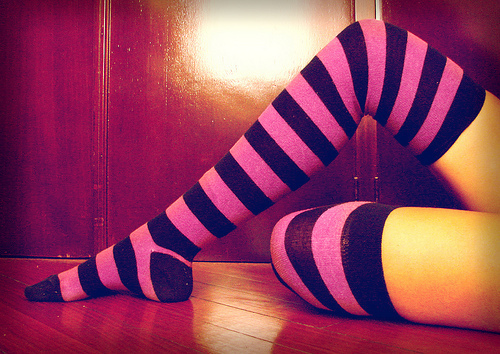
Is it possible to remove fat from specific areas of the body? (Photo of low-fat legs: Kirikiri)
(Preface: This is one of the "bonus chapters" for The 4-Hour Body. My sincerest apologies for the delay! I was hoping to update all of them before posting, but I'll instead get them all up in the next 24 hours. Enjoy! New forums and more coming very soon…)
I'm allergic to food. Every time I eat it breaks out into fat.
—Jennifer Greene Duncan
Does History record any case in which the majority was right?
—Robert Heinlein
In the early 1900s, a 12-year-old girl burned the back of her hand. You are right: this is not newsworthy.
It's what followed the burn, documented in the medical records, that fascinated me:
Doctors used skin from her abdomen as a graft over the burn. By the time this girl turned thirty, she had grown fat, and the skin that had been transplanted to the back of her hand had grown fat as well. "A second operation was necessary for the removal of the big fat pads which had developed in the grafted skin," explained the University of Vienna endocrinologist and geneticist Julius Bauer, "exactly as fatty tissue had developed in the skin of the lower part of the abdomen."
The plight of women and fat is the stuff of legend.
Female fat deposition in the legs and buttocks increases with age, as does abdominal fat and the so-called saddle bags—fat just beneath the hips—in perimenopausal and menopausal women.
How is it that women can eat peanut butter, for example, and seemingly bypass the stomach to put it directly on their asses? Why doesn't this happen to men, who seem to put fat directly on their would-be six-pack, which ends up resembling more of a one-pack (or "six-pack in the cooler"), even if they have bodybuilder-like veins on their arms?
To paraphrase Gary Taubes: some biological factor must regulate this. One candidate is the A-2 receptor, and that is what I decided to look at for practical experimentation…
The A-2 receptor, or alpha-2 andrenergic receptor, is the party spoiler when it comes to fat-loss in gender-specific problem areas. From the journal Obesity Research (bolding is mine):
The fat on women's thighs is more difficult to mobilize due to increased alpha-2 adrenergic receptor activity induced by estrogen. Lipolysis [fat-loss] can be initiated through adipocyte receptor stimulation (beta adrenergic) or inhibition (adenosine or alpha-2 adrenergic) or by inhibition of phosphodiesterase.
In plain Ingrish, this means that estrogen helps pesky fat-mongering A-2 receptors do their work, and there are three effective gambits for losing fat despite this.
For decades, the consensus among exercise professionals has been that spot reduction—reducing fat in one specific body area—is impossible, a myth. I long assumed this was the case until I asked the hypothetical question: if we assume there might be an effective mechanism for spot reduction, what would it look like if we focused on the three above pathways?
It seemed that one answer would be a topical lotion that inhibits the A-2 receptor or blocks phosphodiesterase (1). Another potent and supporting mechanism might be reducing the availability of cortisol at the level of the fat cells themselves (2).
Guess what? There are compounds that can be used for either: aminophylline for the former and glycyrrhetinic acid for the latter.
The two are quite different. Aminophylline is a bronchodilator used for asthma that contains theophylline, a stimulant found in tea that is similar to caffeine. Glycyrrhetinic acid, on the other hand, prevents the breakdown of specific prostaglandins (PGE-2 and PGF-2a) and is derived from licorice; it can be used as a base for expectorants or even artificial sweeteners.
Fat-loss is an off-label use for the latter in particular, but clinical studies indicate that both can selectively reduce thigh fat in females and males when applied as a cream.
During the process of researching this book, I saw firsthand the empirical evidence of spot reduction with low-dose, high-frequency injections of human growth hormone (HGH), but the potential legal ramifications and side effects (like bone and organ growth) make HGH unattractive. If you see bodybuilders with distended abdomens that make them look like they're nine months pregnant, you've probably seen drug-induced visceral organ growth. It's not a look I recommend.
I'd also experimented on three occasions with converting yohimbine HCL into a topical cream based on the writing of Dan Duchaine, but the side effects, including excessive salivation (thank you, autonomous nervous system), weren't worth the negligible fat-loss.
Feeling like a Pavlovian dog about to vomit is no way to spend your life, and abs won't help your sex appeal if you're drooling on yourself.
It Rubs the Lotion on Its Skin
I took a nine-year hiatus from experimenting with spot reduction, until The 4-Hour Body gave me the excuse to fuss with it again.
The research led me to aminophylline and glycyrrhetinic acid. All that remained was to get my hands on both, which I did.
The easiest-to-purchase source of a 2% aminophylline cream was the extremely scammy-sounding Celluthin™, which I ordered on Amazon.
Glycyrrhetinic acid was much harder to locate, as I could only find it through prescription as Atopiclair™, which is used for dermatitis and has a single U.S. distributor in Tennessee, Graceway Pharmaceuticals LLC. Even with prescription-writing doctors willing to indulge me, Graceway made it almost impossible to find the product details and prescribing information for dosing. The latter is needed to write a "script," of course. Eventually we ferreted it out of some subpage on the website, and I was able to fill candidate B at a local Walgreen's within 48 hours.
Celluthin cost $49.99, and Atopiclair topped out at more than $100.
Here's what happened. We'll look at the prescription drug first, for reasons that will become clear.
The Results
Glycyrrhetinic Acid Cream (Atopiclair®)
FIRST, A WARNING FOR WOMEN: Glycyrrhetinic acid inhibits the breakdown of several prostaglandins, including PGF-2a, which therefore increases their levels. Since PGF-2a is known to stimulate uterine activity during pregnancy and can cause miscarriage, glycyrrhetinic acid should not be taken by those who are pregnant or attempting to become pregnant.
I applied Atopiclair thrice daily—upon waking, again at 5:00 P.M., and again before bed—for 13 days. I believe both the effects and potential side effects would have been even more pronounced for a woman:
Before (November 10, 2009) and After (November 23, 2009)
Treated right chest: 5 mm –> 4.43 mm (-.57 mm)
Untreated left chest: 5 mm –> 5.5 mm (+.5 mm)
All measurements were taken at least three times and then averaged. For example, the first "5mm" was derived from readings of 4.9, 5.0, and 5.1 millimeters. But back to our story…
To account for systemic changes, such as diet-induced fat loss or gain, and to create a control, I treated only the right side of my chest on the upper torso. Sites were as far apart as possible and therefore near the armpits.
I lost more than 10% total fat on the treated side and gained exactly 10% on the untreated side. These measurements were clear, and the fat gain on the untreated area made sense, as I was in an overfeeding phase.
The next set of measurements, however, were confusing.
Treated right abdominal: 7.0 mm –> 5.93 mm (-1.07 mm)
Untreated left abdominal: 6.3 mm –> 5.13 mm (-1.17 mm)
The abdominal area I measured is the mid-tier of the six-pack, the second "bump" up from the bottom in the rectus abdominus, or the first "bump" above the navel. I chose this area instead of the usual one inch to either side of the navel because it produced more consistent readings with the ultrasound device I used (4).
You read the data right: though I lost fat on both sides, I lost more fat on the untreated side. No matter how many times I repeated the measurements, that was the conclusion.
Huh?
I have no explanation, other than a possible crossover effect from the topical application, as the measured areas were separated by no more than one inch. I knew this would be a risk—hence the decision to measure the opposing sides of the chest as well.
Can we reconcile the apparent benefit on the chest and the conflicting data from the abs? Not with this alone. There is really only one solution: repeat the test.
Fortunately, our other candidate gave much clearer results.
Aminophylline Cream
Celluthin™ has the following ingredients listed on the label in (assuming this was done as the FTC requires) descending order of volume:
Purified water, Aminophylline, Yerbe Matte, Coleus Forskohli Extract, Oil of Peppermint, Carbomer, Triethanslamide, Liposomes, Butylparaben, Isobutylparaben, Isopropylparaben, Phenoxyethanol, D & C Red #28
I was particularly impressed with the misspellings of both "yerba mate" and "coleus forskohlii." Needless to say, I did not expect this product to have an effect, and I couldn't find clinical support for topical spot reduction use of the ingredients besides aminophylline.
I used the product twice daily on my right thigh only, upon waking and before sleep, for 18 days.
Before (October 12, 2009) and After (October 30, 2009) Measurements:
Treated right thigh midline, six inches above kneecap upper limit: 8.1 mm –> 7.4 mm5 (-0.7)
Untreated left thigh (same measurement): 7.9 mm –> 7.8 mm6 (-0.1)
On the treatment thigh, I lost 8.64% of my fat thickness, as opposed to a 1.26% loss on the control leg. Even more incredible was the apparent persistence of effect after cessation of use.
Here are the same measurements 11 days after I stopped application of the cream:
Right thigh: 7 mm (additional 5.71% reduction, or 0.4 mm)
Left thigh: 8.3 mm (a gain of 0.3 mm)
In other words, even though I was in an overeating phase and gained fat on my left thigh (0.3 millimeters), I continued to lose fat, almost an additional 6%, on the right thigh, which had been previously treated. I didn't believe this outcome and remeasured the sites three times, but the data were consistent.
Consider me a believer.
Based on my experience, using a 2% aminophylline cream for two and a half weeks, applied twice daily, accelerates thigh fat-loss more than 10 times compared to a control.
I'll leave the Atopiclair to the dermatitis sufferers.
Tools and Tricks
Celluthin – The topical lotion containing aminophylline that effectively inhibits the A-2 receptor. Use carefully, as it appears to continue to inhibit this receptor for at least several days after you've stopped using it.
Non-affiliate Amazon link
Affiliate Amazon link (I get a small commission)
Atopiclair (Glycyrrhetinic Acid Cream) (www.atopiclairus.com). Here's where you can find more information about Atopiclair. You won't be able to order the product directly, but you can get rebates on the official site if you decide to apply for a prescription.
Footnotes and References:
1 – This increases cAMP, which facilitates catecholamine stimulation of lipolysis.
2 – Via inhibition of 11beta-hydroxysteroid dehydrogenase type 1.
3 – All measurements were taken at least three times and averaged, in this case from
readings of 4.9, 5.0, and 5.1 millimeters.
4 – Using ultrasound higher than the standard abdominal point, the ultrasound echo
from the fascia (connective tissue) layer can get weaker, which reduces the risk of
the software switching between the fascia and the true fat-muscle interface.
5 – Averaged from measurements of 7.0, 7.3, 7.4, and 7.5 millimeters.
6 – Averaged from measurements of 8.0, 7.8, and 7.8 millimeters.







January 8, 2011
The Perfect Posterior: Kettlebell Swings and Cheap Alternatives

Tracy: 100+ lbs. lost with 2-3 sessions per week.
In The 4-Hour Body, I profiled Tracy R., a mother of two who lost more than 100 pounds.
The secret wasn't marathon aerobics sessions, nor was it severe caloric restriction. It was the Russian kettlebell swing, twice a week for an average of 15–20 minutes. Her peak session length was 35 minutes.
This post will explain how to perform the two-handed kettlebell swing, and it will offer a cheap $10 alternative.
Beyond fat loss, this movement will help build a superhuman posterior chain, which includes all the muscles from the base of your skull to your Achilles tendons. For maximum strength and sex appeal in minimal time, the posterior chain is where you should focus. From "violent hips" for power sports, to the perfect ass for aesthetics, I suggest one starting point:
The Swing
…
(Trouble seeing the videos? Click here, in order, for Kettlebell Swing ABCs and The $10 T-Bar.)
Reps and Sets – Less is More
Long before I met Tracy, I met "The Kiwi" in Buenos Aires, Argentina.
In early 2006, he happened to be taking a private Spanish lesson in the same café where I was finishing the manuscript for The 4-Hour Workweek, and we quickly became close friends. He had competed in elite-level rugby in New Zealand but was equally proud, I soon learned, of applying his BSE in exercise physiology to perfecting the female posterior.
He told me the story over a bottle of Catena Malbec. His obsession started when he saw a professional samba dancer in Brazil balance tequila shots on top of each butt cheek in a dance club. Lamenting the lack of similar scenes in his own country, he set off on a mission to isolate the best exercises for creating buttocks worthy of tequila shots.
By 2000 he had refined his approach to a science. In four weeks, he took his then-girlfriend, an ethnic Chinese with a surfboardlike profile, to being voted one of the top-10 sexiest girls out of 39,000 students at the University of Auckland. Total time: four weeks. Other female students constantly asked her how she'd lifted her glutes so high up her hamstrings.
If The Kiwi could have answered for her, he would have said, "Add reps and weights to the swings."
In 2005, my interest in kettlebells reinvigorated, I returned to the United States from Argentina and purchased one 53-pound kettlebell. I did nothing more than one set of 75 swings one hour after a light, protein-rich breakfast, twice a week on Mondays and Fridays. In the beginning, I couldn't complete 75 consecutive repetitions, so I did multiple sets with 60 seconds between until I totaled 75. Total swing time for the entire week was 10–20 minutes.
I wasn't trying to balance tequila shots on my butt cheeks. I wanted clear six-pack abs. In six weeks, I was at my lowest bodyfat percentage since 1999, and l'd reached my goal. I've since worked up to 50+ reps with the 106-lb. "beast" (video), which has directly transferred to 100-lb.+ gains in the deadlift.
The king of exercises—the two-handed kettlebell swing—is all you need for dramatic changes.
Here are a few guidelines:
• Stand with your feet 6–12 inches outside of shoulder width on either side, each foot pointed outward about 30 degrees. If toes pointed straight ahead were 12:00 on a clock face, your left foot would point at 10:00 or 11:00, and your right would point at 1:00 or 2:00.
• Keep your shoulders pulled back (retracted) and down to avoid rounding your back.
• The lowering movement (backswing) is a sitting-back-on-a-chair movement, not a squatting- down movement.
• Do not let your shoulders go in front of your knees at any point.
• Imagine pinching a penny between your butt cheeks when you pop your hips forward. This should be a forceful pop, and it should be impossible to contract your ass more. If your dog's head gets in the way, it should be lights out for Fido.
75 total reps, 2-3 times a week, is the recipe.
Simple works.
###
Odds and Ends: An Appeal
George Bush 691 vs. 4-Hour Body 427 –
Since the book came out, I've fantasized about having more Amazon reviews than George Bush. Now, it's actually possible! The ask: If you've enjoyed the 4-Hour Body, could you pretty please take 30 seconds to leave a short Amazon review here?
I'll toast some wine and do a thank-you video this weekend if I crush The Decider. Thanks in advance — it's been an exciting few weeks, and this would really be the icing on the cake.
December 24, 2010
THANK YOU, THANK YOU, THANK YOU…

(Photo: Garland Cannon)
It was just past 5pm EST in Manhattan, and I'd been on pins and needles all day.
The report was coming in any minute. All attempts to nap earlier, despite two hours of sleep, had failed. There would be no rest on this Wednesday.
Now, in the lobby of the ACE Hotel, a few friends — including my agent, Steve Hanselman, my assistant, Charlie Hoehn, and my brother from another mother, Chris — had gathered with me to drink champagne. No matter the outcome, it had been a hard-fought battle over three years. THREE YEARS. Hospitalizations, surgeries, you name it.
I stared at the floor, reciting the reasons why things could go right. Most of them were silly and superstitious. Then my internal devil's advocate chimed in with the reasons other books would beat me: better retail placement, celebrity authors, dedicated TV shows, etc.
"It's here."
I looked up. Steve smiled and handed me his Blackberry:
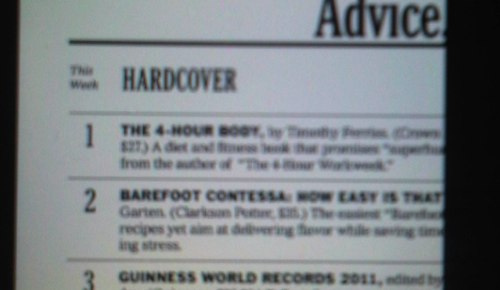
#1: The 4-Hour Body.
The 4-Hour Body had hit #1 on The New York Times bestseller list, on the hardest list (Advice, How-To) during the hardest week of the year.
I was in shock for the rest of the evening.
THANK YOU
For the rest of the night, as my friends fed me shots, I thought back to 2007, when The 4-Hour Workweek was turned down by 26 out of 27 publishers.
Everything that I've experienced in the last three years is thanks to you. I learn more from you than I could ever teach.
Much more to come soon (including a detailed post-game analysis of the launch), but — for the time being — I'll keep it simple: THANK YOU.
I love you all.
May you and yours have the most joyous of holidays. Now, I need to get to wine and chocolate with the family… :)
Merry Christmas! 2011 is going to be the best year yet for all of us!
Un abrazo grande,
Tim

